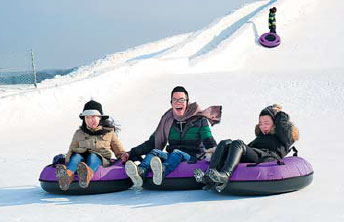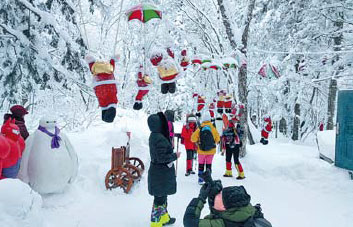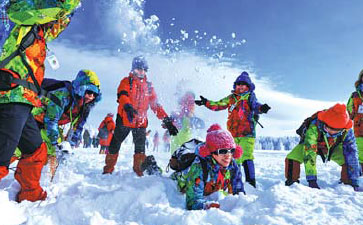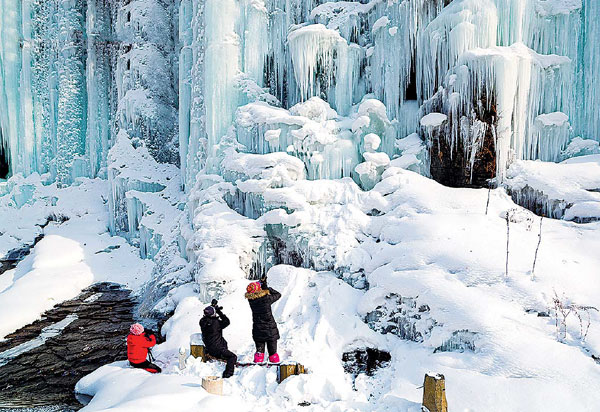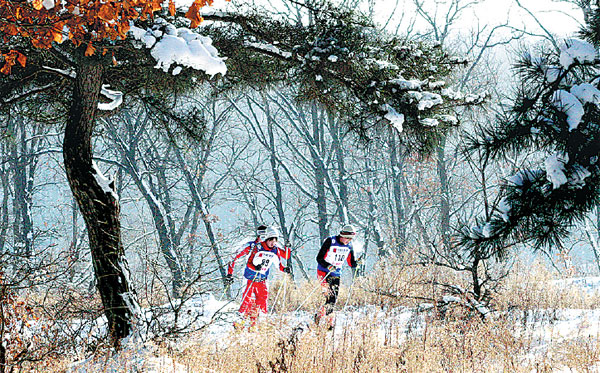Snow, ice tourism to be pillar industry
Skiing, mountain pursuits attract growing number of tourists and levels of investment in Northeast province
On the white snowy blankets of Daqing Mountain in Jilin province, tourists trek uphill with snowboards, helmet and ski suits of different colors. Some sit in a cafe at the top of the mountain, overlooking Songhua Lake fenced in by far off hills.
The mountain is located in Vanke Songhua Lake Resort, one of the 37 ski resorts in Northeast China's Jilin province.
Jilin, rich in ice and snow resources in terms of volume and quality during its long winter, is determined to promote ice and snow economy.
During this year's Spring Festival, the number of tourists who visited Jilin province grew by 20.02 percent year-on-year to 10.7 million. Total tourism income across the province in the period reached 9.7 billion yuan ($1.4 billion), up 28.13 percent year-on-year, according to the local statistics agency.
Dong Dong, sales manager at Vanke Songhua Lake Resort, said the number of visitors it received reached 200,000 by 2015, growing to 300,000 last year with a total income of 150 million yuan.
Beyond ski runs, the resort is also equipped with restaurants, holiday apartments, commercial streets and skiing training schools, Dong said.

Tian Yong, a tourist from Shenzhen in South China's Guangdong province came to visit for the first time this year.
"The beauty of the ice and snow deeply impressed me. I couldn't imagine there was so much winter fun in Northeast China," said Tian.
Another tourist, Sun Jingjing from Shanghai, said the trip changed the image of Jilin in her eyes.
"I used to think of Jilin as a cold and less developed place. But on my trip, I found the city's infrastructure convenient and the locals hospitable. I will bring my family and friends here next year," Sun said.
As the 2022 Winter Olympics in Beijing and Zhangjiakou approaches, the local government plans to develop ice and snow tourism by constructing more ski resorts and snow sculpture parks, and by developing leisure travel and high-mountain extreme skiing, according to an official document released in September 2016.
Yang Andi, director of the Jilin Tourism Development Commission, said the organization expects the number of ice and snow tourists to grow by 20 percent and income by 28 percent in March, year-on-year.
"We have great confidence since the ski resorts are packed with people even at night," Yang said.
The local ski resorts include those that combine winter sports with leisure travel and entertainment, such as Changbai Mountain International Resort, Vanke Songhua Lake Resort and Beidahu ski resort.
Lianhua Mountain and Wujia Mountain ski resorts can provide spaces for skiers at different proficiency levels.
Ski resorts in urban cities are also available for beginners' practice sessions, including Miaoxiang Mountain, Xinli Lake and Cilu Lake ski resorts.
Wide range of activities
Songhua River, which does not freeze in winter, also draws athletes from home and abroad to compete in dragon-boat races during the annual Tree Frost, Ice and Snow Festival held in the city of Jilin in Jilin province from December to February.
In December 2016, about 300 players from Russia, Belarus, Beijing, Macao, Fujian province and Jilin attended the event.
Xiao Canrong, 64, participated in the competition with 22 team members from Macao.
"Frozen and snow-covered Jilin has a unique beauty, which is very different from Macao. It is the only place to hold dragon boat racing in winter," said Xiao. "I love this sport. It's the second time for me to come here."
Nafalia Zaitseve from Russia accompanied her husband to attend the race with their 3-year-old daughter.
"Jilin is warmer than Russia. It's very beautiful here," she said.
During the three-month event, more than one hundred sports events and cultural activities were organized, including lion dances, dragon boat racing, ice and snow cultural forums, exhibitions of local specialties and freestyle skiing competitions.
The first China Jilin International Ice and Snow Tourism Industry Expo, which just closed in December 2016, saw the signing of contracts worth 180 million yuan and total transactions worth 220 million yuan, Cao Guangbin, an official of the Changchun city tourism administration, said at a news conference on Dec 13.
During the four-day event, 183 exhibitors displayed their ice- and snow-related products, from 15 countries and regions including the United States, Canada, Germany, Italy and Russia, Cao said.
The exhibits included snow-making machines, snow ploughs, snow mobiles and ski goggles. Organizers also held activities such as curling matches, snowboarding performances and indoor simulative skiing.
Focus on quality growth
Tourism will become the fourth pillar industry of Jilin province, according to officials at a provincial tourism working conference held in February.
The province plans to focus on the development of ice and snow tourism in winter and cooling travel in summer by launching more big projects, promoting industrial integration and improving the environment.
Yang Andi, director of the Jilin Tourism Development Commission, said at the conference that the number of tourists in 2016 reached 165.79 million, up 17.3 percent year-on-year. She expects the figure to grow by a further 15 percent to 190 million in 2017.
The province's total tourism income in 2016 was about 289.7 billion yuan, a 25.15 percent rise year-on-year. The commission expects that the number to reach 347.7 billion yuan in 2017, with a growth rate of 20 percent.
The currently quickening pace of tourism will slow down in 2017 though, Yang said.
"We are not chasing blind growth, but paying more attention to improvements and the quality and healthy development of the industry," she said.
Northeast China has its own advantage, although it is not developing as quickly as coastal cities.
Wei Xiao'an, director of the World Tourism Cities Federation, said: "China has rich ice and snow resources, but only a few cities are able to form an industrial cluster of ice and snow products. The landscape and temperature of Jilin province are suitable to develop the ice and snow industry and related tourism projects have sprung up."
Wei said Jilin should develop its ice and snow industry with compound modes - sightseeing brings popularity, leisure travel brings income and cultural tourism brings fame.
"The ice is cold, but the service should be warm to make tourists feel at home," he added.
chenmeiling@chinadaily.com.cn
|
Tourists toboggan at Wasa Skiing Festival in Changchun, Jilin. Photos Provided To China Daily |
|
The fourth City of Helong and Laolike Lake Snow Festival opens in December last year. Zhao Hongliang / For China Daily |
|
Tourists play with snow in Laolike Lake scenic area in Yanbian Korean autonomous prefecture. An Zhenli / For China Daily |
|
Tourists take photos of a frozen Bailong waterfall at Shiwudaogou in Baishan county, Jilin. Ding Lianguo / For China Daily |
|
Tourists ski at the Wasa Skiing Festival in Changchun. Jilin province is developing its ice and snow tourism facilities. |
(China Daily 03/14/2017 page18)


